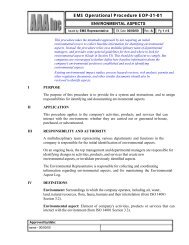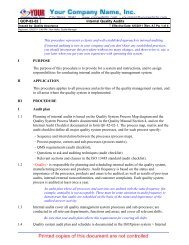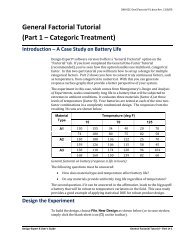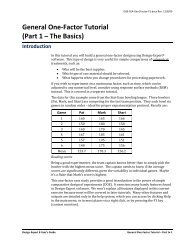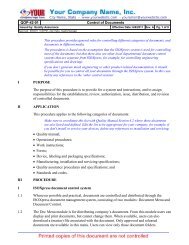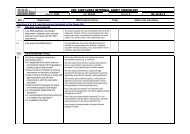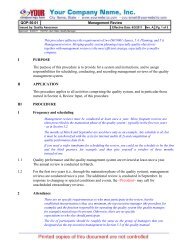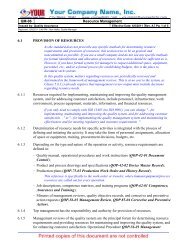QMS Operational Procedure QOP-56-01 - Quality Coach
QMS Operational Procedure QOP-56-01 - Quality Coach
QMS Operational Procedure QOP-56-01 - Quality Coach
- No tags were found...
You also want an ePaper? Increase the reach of your titles
YUMPU automatically turns print PDFs into web optimized ePapers that Google loves.
<strong>QMS</strong> <strong>Operational</strong> <strong>Procedure</strong> <strong>QOP</strong>-<strong>56</strong>-<strong>01</strong>MANAGEMENT REVIEWIssued by: <strong>Quality</strong> Assurance Eff. Date: 00/00/00 Rev.: A Pg. 1 of 6IIIIIIThis procedure addresses the requirements of two ISO 90<strong>01</strong> clauses, 5.4, Planning,and 5.6, Management review. Merging quality system planning (especially qualityobjectives) together with management reviews is the most efficient strategy, especiallyfor a smaller company.PURPOSEThe purpose of this procedure is to provide for a system and instructions, and to assignresponsibilities for scheduling, conducting, and recording management reviews of thequality management system.APPLICATIONThis procedure applies to all activities comprising the quality system, and in particularthose named in Section 4, Review Input, of this procedure.PROCEDURE1 Frequency and schedulingManagement reviews must be conducted at least once a year. More frequent reviewsare often prescribed in the maturation phase of the quality system - typically in thefirst two years - as in Section 1.2.The months of March and September are used here only as an example. Any scheduleis ok, but it must be synchronized with the cycle for internal audits (8.2) andcompilation of quality performance data (8.4).If you need a wider timeframe for scheduling the review, you could set the schedule tobe the first and the third quarters, for example, and thus give yourself a window ofthree months, instead of one.1.1 <strong>Quality</strong> performance and the quality management system are reviewed at least once ayear. The annual review is conducted in March.1.2 For the first two years (i.e., through the maturation phase of the quality system),management reviews are conducted twice a year. The additional review is conductedin September. In response to changing or special conditions and events, the may call for unscheduled extraordinary reviews.2 AttendanceThere are no specific requirements as to who must participate in the review, but theestablished interpretation is that, at a minimum, the top executive manager (thepresident, for example) and the function responsible for operating the quality system(the quality manager, for example) must always be present. Otherwise, there are nospecific expectations to who else should participate.The list of participants should be roughly the same as the group of managers that youdesignated as the top executive management in Section 5.5 of the quality manual.Approved by/date:name - 00/00/00
MANAGEMENT REVIEW<strong>Operational</strong> <strong>Procedure</strong> <strong>QOP</strong>-<strong>56</strong>-<strong>01</strong> Rev.: A Pg. 3 of 6• Corrective and preventive actions: presents the most importantcorrective and preventive actions implemented through the period, and the status ofpending actions.• Customer feedback and complaints: presents summaries ofcustomer feedback and customer complaints, including analysis of trends.• Internal quality audits: presents results of internal quality systemaudits. This includes summaries of results for the cycle, the frequency of auditfindings against particular elements of the quality system and discussion ofsignificant findings.• Changes and quality system planning: highlights any product, process,capacity, or other operational or organizational changes that affect the qualitysystem and proposes specific actions to update or modify the system in response tothese changing circumstances.• Recommendations for improvement: concludes the input phase of thereview with recommendations for improvement..In addition to the topics listed above, the management review may also consider suchissues as cost of quality and non-quality; integration of the quality system with otheroperations and activities; market and customer response to the quality effort; and anyother such issues related to the quality management system.4.2 Following each presentation, the participants discuss the issues, compare their statusand performance with preceding periods, and identify areas where improvement isrequired.5. <strong>Quality</strong> objectives and quality policyISO 90<strong>01</strong> Clause 5.4.1 requires that quality objectives must be consistent with thequality policy, be established at all relevant functions and levels within theorganization, and be measurable. The most common compliance problem is thatquality objectives are not measurable and/or are not measured. Behind everyobjective there must be a system for measuring performance and systematicallycollecting the data. Objectives cannot be a list of asp rational wishes or marketingslogans.From compliance point of view, the most efficient strategy is to establish objectives inthe areas where performance data are already available, either because recording thedata is required by the ISO 90<strong>01</strong> standard, or because the data have been collectedbefore and are available. The types of data that are required by ISO 90<strong>01</strong> and couldbe used are: customer complaints – the objective could be to decrease their number;product and process nonconformities – the objective could be to decrease theirnumber overall, or for specific processes, products or types of nonconformities;corrective actions – the objective could be to decrease the time it takes to implement acorrective action (decreasing the number of corrective actions is not necessarily ameasure of improvement); and so forth.In fact, any time you can easily extract some performance data from a record that issystematically maintained, you have a candidate for an objective. Other popularobjectives tied to performance that can be easily tracked are product returns, scrap
MANAGEMENT REVIEW<strong>Operational</strong> <strong>Procedure</strong> <strong>QOP</strong>-<strong>56</strong>-<strong>01</strong> Rev.: A Pg. 4 of 6rates, rework, inventory turn-over, set-up cycle, warranty cost, on-time delivery,machine down time, etc.In service industries, typical objectives are to reduce customer waiting time, decreasecustomer use of technical support, increase ration of repeat customers (customerloyalty), increase scoring for specific questions on customer satisfaction surveys, andso forth.Be sure that the choice of your objectives is closely aligned with the system forcollecting and analyzing quality performance data required in Clause 8.4 of the ISO90<strong>01</strong> standard. To comply with this clause you must collect certain types of data, sowhy not use the same data to monitor your objectives.Auditors will expect you to have about four to seven objectives. Anything less thanthree or more than ten will be viewed with suspicion and provoke questioning thatmay lead to a finding.5.1 An important role of management reviews is to establish quality objectives and toreview progress toward achieving the objectives and fulfilling the quality policy.<strong>Quality</strong> objectives are established to improve performance and/or the quality systemand thus fulfill the quality policy and other organizational goals and aspirations.5.2 At the end of the meeting, presents the status of quality objectivesestablished by the previous review (those objectives are documented on the title pageof the Management Review Report); and records their status in the Status Next MngmtReview column.5.3 When an objective is not achieved, the participants decide whether to drop theobjective, reduce its target value, or extend the target due date. Objectives that havebeen achieved may be discontinued or be retained with a higher target value.5.4 Any quality objectives that are carried on into the next period and any new objectivesestablished by the review meeting are documented in the <strong>Quality</strong> Objectives Matrix onthe title page of the Management Review Report.5.5 The principal quality policy is reviewed to ensure its continuing suitability. The policyis changed when the goals expressed in the policy have been achieved, or whenchanges within or outside the company render the policy inadequate or inappropriate.6 Management review outputThe scope of the review output defined below is pretty much dictated by the standard,and there is not much room for change. The strategy here is to credit improvementactions as quality objectives (5.4.1) and as evidence of satisfying requirements forcontinual improvement (8.5.1).6.1 Management reviews are concluded with actions related to:• Improvement of the quality management system,• Improvement of quality performance, and• Improvement of products and/or services to better meet customer requirements andincrease customer satisfaction.
MANAGEMENT REVIEW<strong>Operational</strong> <strong>Procedure</strong> <strong>QOP</strong>-<strong>56</strong>-<strong>01</strong> Rev.: A Pg. 5 of 66.2 These improvement actions are defined implemented as• Management review actions: Documented in the Management Review Report(QF-<strong>56</strong>-<strong>01</strong>-1) in the Actions, Assigned to, and Due Date columns. This type ofaction is most suitable for minor improvements that can be quickly implemented,and which are not directly related to product or process conformity.• Corrective or preventive actions: Documented in the Corrective Action Request(CAR) form (QF-85-03-1) and processed in accordance with procedure <strong>QOP</strong>-85-03,Corrective and Preventive Actions. CARs are normally used for improvementsrelated to specific actual or potential product or process nonconformities.• <strong>Quality</strong> objectives: Documented on the title page of the Management ReviewReport (refer to Section 6 of this procedure). This method is most suitable forimplementing long term improvement goals.6.3 Resource needs for implementing improvement actions are identified. This includeassignment of responsibility, time frame, and allocation of human, equipment,technical knowledge, and other necessary resources.8 RecordManagement review records must be as comprehensive as possible. They will be thesole evidence that the agenda of the review was completely covered, and that thereview was concluded with appropriate decisions and actions.Although it is ok to classify management review records as confidential, you cannotrefuse to show these records to certification auditors. You could, however, denyaccess to anyone else auditing your system, on the basis that the records have beenalready audited by your registrar.8.1 Management review output is documented in the Management Review Report basedon form QF-<strong>56</strong>-<strong>01</strong>-1. The report is prepared by and is distributed to theattending and, if any, absent participants. The location and retention period formanagement review records are specified in <strong>Operational</strong> <strong>Procedure</strong> <strong>QOP</strong>-42-02,Control of Records.IVVREFERENCED DOCUMENTS• Form QF-<strong>56</strong>-<strong>01</strong>-1, Management Review Report• <strong>Operational</strong> <strong>Procedure</strong> <strong>QOP</strong>-42-02, Control of Records• <strong>Operational</strong> <strong>Procedure</strong> <strong>QOP</strong>-85-03, Corrective and Preventive ActionASSOCIATED RECORDS• Management Review Report: Record of the management review meeting, toinclude presented and discussed topics and issues; conclusions, policies andchanges; and any actions initiated to implement the conclusions and policies.Documented using form QF-<strong>56</strong>-<strong>01</strong>-1, Management Review Report.Auditors may also ask for copies of reports, charts, overheads and other suchmaterials presented at the management review meeting. But lack of such recordswould not necessarily be a noncompliance, especially in a smaller company. The
MANAGEMENT REVIEW<strong>Operational</strong> <strong>Procedure</strong> <strong>QOP</strong>-<strong>56</strong>-<strong>01</strong> Rev.: A Pg. 6 of 6presentations may be verbal.• <strong>Quality</strong> Objectives Matrix: Record of established quality objectives. Documentedon the title page of the Management Review Report (QF-<strong>56</strong>-<strong>01</strong>-1).
<strong>QMS</strong> <strong>Operational</strong> <strong>Procedure</strong> <strong>QOP</strong>-82-02INTERNAL QUALITY AUDITSIssued by: <strong>Quality</strong> Assurance Eff. Date: 00/00/00 Rev.: A Pg. 1 of 5This procedure represents a classic and well-established approach to internalauditing.If internal auditing is new in your company and you don't have any establishedpractices, you should incorporate this procedure without too many changes, and thenreview it, say, a year later when you get your own experience with operating thissystem.IPURPOSEThe purpose of this procedure is to provide for a system and instructions, and to assignresponsibilities for conducting internal audits of the quality management system.IIAPPLICATIONThis procedure applies to all processes and activities of the quality managementsystem, and to all areas where the quality system is implemented.IIIPROCEDURE1 Audit plan1.1 Planning of internal audits is based on the <strong>Quality</strong> System Process Map diagram andthe <strong>Quality</strong> System Process Matrix documented in the <strong>Quality</strong> Manual Section 4, andon the Internal Audit Checklist documented in form QF-82-02-3. The process map,matrix and the audit checklist define all major quality system processes, and for eachprocess specify:• Sequence and interrelation between the processes (process map),• Process purpose, owners and sub-processes (process matrix),• <strong>QMS</strong> requirements (audit checklist),• Questions to ask and auditing techniques (audit checklist)• Relevant sections and clauses in the ISO 90<strong>01</strong> standard (audit checklist).1.2 is responsible for planning and scheduling internal audits of the qualitysystem, manufacturing processes and products. Audit frequency is based on the statusand importance of the processes, products and areas to be audited, as well as results ofprevious audits, internal/external nonconformities, and customer complaints. Eachquality system process is audited at least once a year.An audit plan where all processes and activities are audited with the same frequency(for example, annually) is not acceptable. There must be some variation in auditfrequency to demonstrate that audits are scheduled on the basis of the status andimportance of the audited area or activity.Approved by/date:name - 00/00/00
INTERNAL QUALITY AUDITS<strong>Operational</strong> <strong>Procedure</strong> <strong>QOP</strong>-82-02 Rev.: A Pg. 2 of 51.3 Internal audits cover all quality management system processes and sub-processes; areconducted in all relevant departments, functions and areas; and cover all relevantshifts.Be sure that your audit plan reflects this requirement for covering all shifts.1.4 <strong>Quality</strong> system audit plan and schedule is documented in a matrix, a model of which isprovided in form QF-82-02-1, Internal Audit Plan. The vertical side of the matrix listsprocesses of the quality system to be audited and the horizontal side lists audit datesand assigned auditors. More detailed scope and reference for the audit, to includerelevant sub-processes, procedures, areas/functions and reference clauses of ISO 90<strong>01</strong>standard, are provided in the <strong>Quality</strong> System Process Map diagram (QM 4.1.1), the<strong>Quality</strong> System Process Matrix (QM 4.1.1), and the Internal Audit Checklist (formQF-82-02-3).Note that QF-82-02-1 is actually just the schedule component of the internal auditplan. The actual scope and reference for the internal auditing program are defined inthe <strong>Quality</strong> System Process Map diagram, the <strong>Quality</strong> System Process Matrix, and theInternal Audit Checklist.1.5 Internal audit plans and cycles are synchronized with management reviews of thequality system (refer to <strong>Operational</strong> <strong>Procedure</strong> <strong>QOP</strong>-<strong>56</strong>-<strong>01</strong>, Management Review), sothat complete results from the full auditing cycle are available in time for themanagement review meeting.2 Audit team2.1 is responsible for qualifying, training and assigning internal auditors.Personnel assigned to carry out internal audits are independent of those having directresponsibility for the audited activity.Edit this as appropriate to your company, but be sure to clearly communicate therequirement for objectivity and impartiality of the auditor.2.2 Internal auditors are qualified on the basis of their education, experience and training.Minimum requirements are:• Education: High School graduation• Experience: Two years in the industry• Training: 16 hours external or in-house trainingThe training can be by an external course or seminar provided by a qualifiedinstitution (such as a registrar, accredited training organization, etc.), or in-housetraining provided by a qualified consultant/trainer. If training is provided in-house, thetrainer must have documented qualifications as a Lead Auditor.The standard explicitly requires that internal auditors must be qualified, but does notstate any particular qualification criteria. The criteria defined in this clause are justan example.
INTERNAL QUALITY AUDITS<strong>Operational</strong> <strong>Procedure</strong> <strong>QOP</strong>-82-02 Rev.: A Pg. 3 of 53 Preparing for audit3.1 Auditors prepare for an audit by:• Reviewing the <strong>Quality</strong> System Process Map diagram, the <strong>Quality</strong> System ProcessMatrix (documented in the <strong>Quality</strong> Manual Section 4), and the Internal AuditChecklist (documented in QF-82-02-3);• Refreshing their knowledge of the quality manual and relevant operationalprocedures;• Reviewing nonconformity reports, customer complaints, and corrective action files;and• Customizing and augmenting (as necessary) the Internal Audit Checklist.4 Conducting and reporting the audit4.1 The manager responsible for the area scheduled for audit is contacted at least oneweek in advance with the proposed audit date. The manager responds with aconfirmation, or proposes an alternative date.4.2 In conducting the audit, auditors generally follow the Internal Audit Checklist (QF-82-02-3). The checklist defines the minim scope criteria (requirements) for the audit andprovides examples of relevant questions and auditing techniques. The checklist is alsoused for referencing reviewed evidence and keeping audit notes.4.3 When a nonconformity is noted, it is brought to the attention of, and discussed with,the responsible manager. Before the end of the audit each noted nonconformity isdocumented using the Audit Nonconformity Report form (a model of the form isprovided in QF-82-02-2, Audit Nonconformity Report). Auditors fill out only the firstpart of the form, describing the noted nonconformity. The form is then handed over tothe responsible manager who uses its second part to propose a corrective action.5 Corrective action and follow upIn this procedure, the process for requesting and implementing corrective actionsresulting from audit findings is incorporated into the Audit Nonconformity Reportform. Thus, the general Corrective and Preventive Action procedure and form do notapply to audits. While, in theory, the general Corrective and Preventive Action systemcould be used for internal audit findings, it is not a good idea. Audit findings mustalways be addressed as a priority, and within a specified time frame; because an openfinding means that the quality system is technically in default.5.1 Once a nonconformity is identified and documented, further processing of thenonconformity report is similar to the corrective action requests (<strong>Operational</strong><strong>Procedure</strong> <strong>QOP</strong>-85-03, Corrective and Preventive Action). Upon receiving the report,the responsible manager investigates the cause of the problem noted as anonconformity, proposes a corrective action to be taken, and indicates the date bywhich the corrective action will be fully implemented. The auditor reviews and
INTERNAL QUALITY AUDITS<strong>Operational</strong> <strong>Procedure</strong> <strong>QOP</strong>-82-02 Rev.: A Pg. 4 of 5approves the proposed action.5.2 On, or immediately after the due date for implementation of corrective action, theauditor follows up with an inquiry or an audit to determine if the corrective action hasbeen implemented and if it is effective. When there is objective evidence that thecorrective action is effective, the nonconformity report is closed out. If more work isneeded to fully implement the action, a new follow-up date is agreed upon.6 Documentation and records6.1 The scope of the audit, references to objective evidence and general audit notes aredocumented in the Internal Audit Checklist (QF-82-02-3).6.2 Nonconformities, implementation of resulting corrective actions, and follow-up auditsare documented using the Audit Nonconformity Report form, a model of which isprovided in Form QF-82-02-2, Audit Nonconformity Report.6.3 The first block of the form contains a description of the nonconforming condition, thesecond block contains the proposal for a corrective action, and the third block isreserved for the follow-up audit and close-out of the report.6.4 Pending nonconformity reports are kept by the auditor who initially issued the report.Closed-out nonconformity reports are kept by .6.5 At the end of an auditing cycle, all nonconformity reports established during the cycleare compiled and analyzed, and are presented at the management review meeting(refer to <strong>Operational</strong> <strong>Procedure</strong> <strong>QOP</strong>-<strong>56</strong>-<strong>01</strong>, Management Review).IVASSOCIATED DOCUMENTS• QM Section 4.1.1, <strong>Quality</strong> System Process Map diagram• QM Section 4.1.1, <strong>Quality</strong> System Process Matrix• Form QF-82-02-1, Internal Audit Plan• Form QF-82-02-2, Audit Nonconformity Report• Form QF-82-02-3, Internal Audit Checklist• <strong>Operational</strong> <strong>Procedure</strong> <strong>QOP</strong>-42-02, Control of Records• <strong>Operational</strong> <strong>Procedure</strong> <strong>QOP</strong>-<strong>56</strong>-<strong>01</strong>, Management Review• <strong>Operational</strong> <strong>Procedure</strong> <strong>QOP</strong>-85-03, Corrective and Preventive ActionVASSOCIATED RECORDS• Internal audit plans: Plans for quality management system audits. Based on FormQF-82-02-1, Internal Audit Plan.• Internal Audit Checklists: Checklist filled out with comments and referencesnoted by auditors during the audit. Established using form QF-82-02-3, Internal
INTERNAL QUALITY AUDITS<strong>Operational</strong> <strong>Procedure</strong> <strong>QOP</strong>-82-02 Rev.: A Pg. 5 of 5Audit Checklist.• Audit Nonconformity Reports: Reports with audit findings and records ofcorresponding corrective actions. Established by auditors using Form QF-82-02-2,Audit Nonconformity Report.



